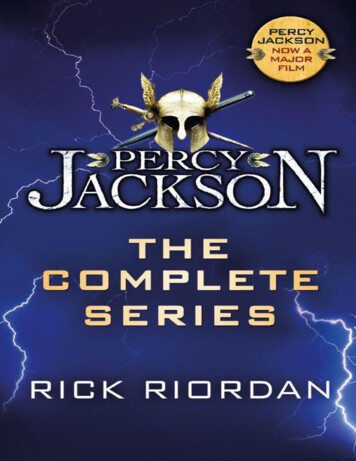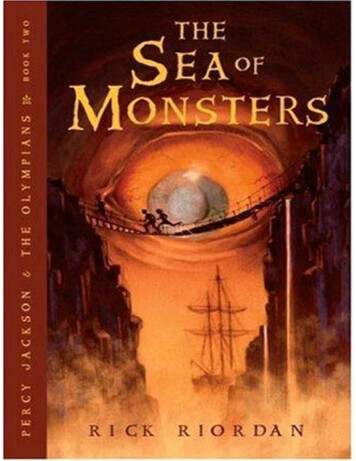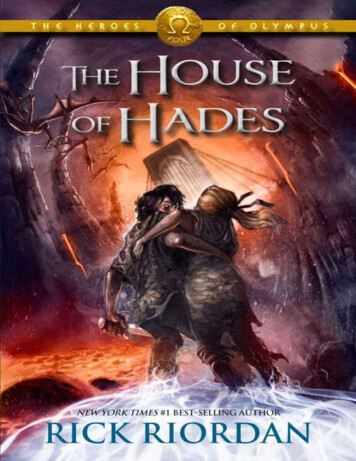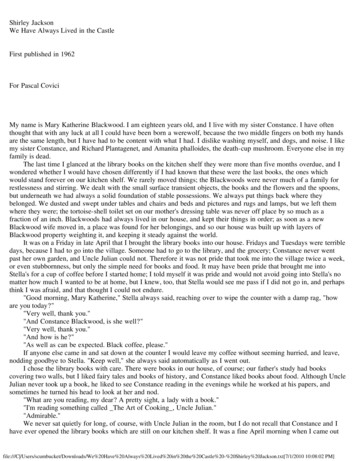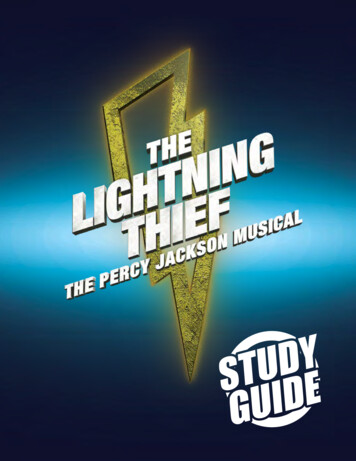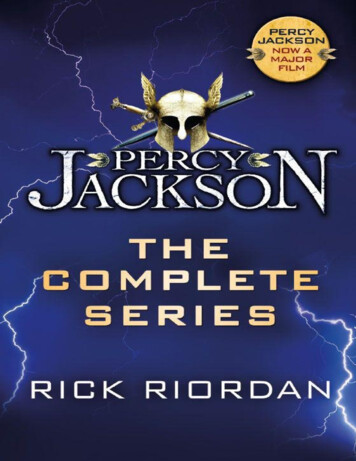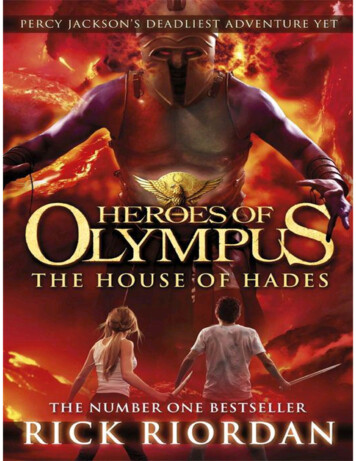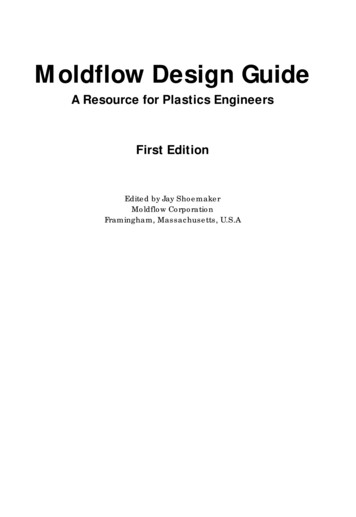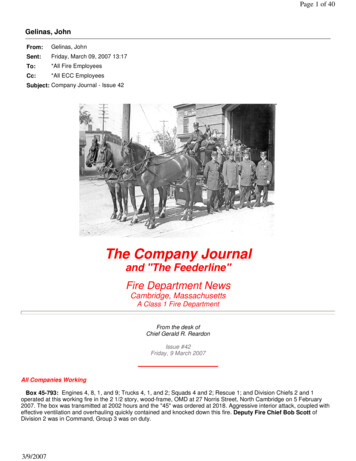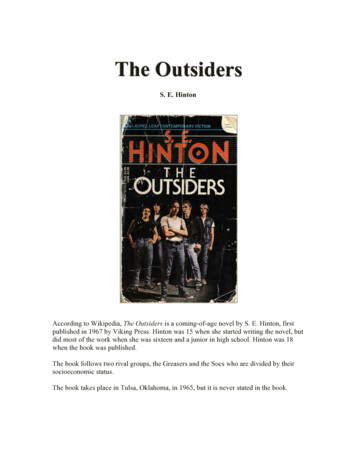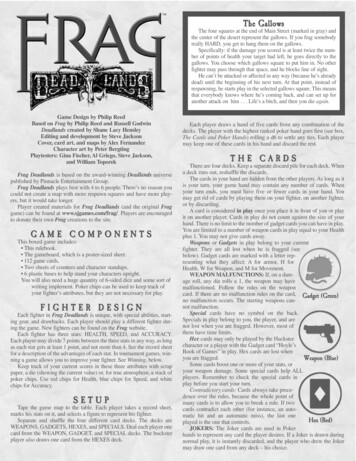
Transcription
The GallowsThe four squares at the end of Main Street (marked in gray) andthe center of the desert represent the gallows. If you frag somebodyreally HARD, you get to hang them on the gallows.Specifically: if the damage you scored is at least twice the number of points of health your target had left, he goes directly to thegallows. You choose which gallows square to put him in. No otherfighter may pass through that space, and he blocks line of sight.He can’t be attacked or affected in any way (because he’s alreadydead) until the beginning of his next turn. At that point, instead ofrespawning, he starts play in the selected gallows square. This meansthat everybody knows where he’s coming back, and can set up foranother attack on him . . . Life’s a bitch, and then you die again.Game Design by Philip ReedBased on Frag by Philip Reed and Russell GodwinDeadlands created by Shane Lacy HensleyEditing and development by Steve JacksonCover, card art, and maps by Alex FernandezCharacter art by Peter BergtingPlaytesters: Gina Fischer, Al Griego, Steve Jackson,and William ToporekFrag Deadlands is based on the award-winning Deadlands universepublished by Pinnacle Entertainment Group.Frag Deadlands plays best with 4 to 6 people. There’s no reason youcould not create a map with more respawn squares and have more players, but it would take longer.Player created materials for Frag Deadlands (and the original Fraggame) can be found at www.sjgames.com/frag/. Players are encouragedto donate their own Frag creations to the site.GAME COMPONENTSThis boxed game includes: This rulebook. The gameboard, which is a poster-sized sheet. 112 game cards. Two sheets of counters and character standups. 6 plastic bases to help stand your characters upright.You will also need a huge quantity of 6-sided dice and some sort ofwriting implement. Poker chips can be used to keep track ofyour fighter’s attributes, but they are not necessary for play.FIGHTER DESIGNEach fighter in Frag Deadlands is unique, with special abilities, starting gear, and drawbacks. Each player should play a different fighter during the game. New fighters can be found on the Frag website.Each fighter has three stats: HEALTH, SPEED, and ACCURACY.Each player may divide 7 points between the three stats in any way, as longas each stat gets at least 1 point, and not more than 4. See the record sheetfor a description of the advantages of each stat. In tournament games, winning a game allows you to improve your fighter. See Winning, below.Keep track of your current scores in these three attributes with scrappaper, a die (showing the current value) or, for true atmosphere, a stack ofpoker chips. Use red chips for Health, blue chips for Speed, and whitechips for Accuracy.SETUPTape the game map to the table. Each player takes a record sheet,marks his stats on it, and selects a figure to represent his fighter.Separate and shuffle the four different card decks. The decks areWEAPONS, GADGETS, HEXES, and SPECIALS. Deal each player onecard from the WEAPON, GADGET, and SPECIAL decks. The hucksterplayer also draws one card from the HEXES deck.Each player draws a hand of five cards from any combination of thedecks. The player with the highest ranked poker hand goes first (see box,The Cards and Poker Hands) rolling a d6 to settle any ties. Each playermay keep one of these cards in his hand and discard the rest.THE CARDSThere are four decks. Keep a separate discard pile for each deck. Whena deck runs out, reshuffle the discards.The cards in your hand are hidden from the other players. As long as itis your turn, your game hand may contain any number of cards. Whenyour turn ends, you must have five or fewer cards in your hand. Youmay get rid of cards by playing them on your fighter, on another fighter,or by discarding.A card is considered in play once you place it in front of you or playit on another player. Cards in play do not count against the size of yourhand. There is no limit to the number of gadget cards you can have in play.You are limited to a number of weapon cards in play equal to your Healthplus 1. You may not give cards away.Weapons or Gadgets in play belong to your currentfighter. They are all lost when he is fragged (seebelow). Gadget cards are marked with a letter representing what they affect: A for armor, H forHealth, W for Weapon, and M for Movement.WEAPON MALFUNCTIONS: If, on a damage roll, any die rolls a 1, the weapon may havemalfunctioned. Follow the rules on the weaponcard. If there are no malfunction rules on the card, Gadget (Green)no malfunction occurs. The starting weapons cannot malfunction.Special cards have no symbol on the back.Specials in play belong to you, the player, and arenot lost when you are fragged. However, most ofthem have time limits.Hex cards may only be played by the Huckstercharacter or a player with the Gadget card “Hoyle’sBook of Games” in play. Hex cards are lost whenyou are fragged.Weapon (Blue)Some cards boost one or more of your stats, oryour weapon damage. Some special cards help ALLplayers. Remember to check the special cards inplay before you start your turn.Contradictory cards: Cards always take precedence over the rules, because the whole point ofmany cards is to allow you to break a rule. If twocards contradict each other (for instance, an automatic hit and an automatic miss), the last oneHex (Red)played is the one that controls.JOKERS: The Joker cards are used in Pokerhands to represent any card the player desires. If a Joker is drawn duringnormal play, it is instantly discarded, and the player who drew the Jokermay draw one card from any deck – his choice.
The Cards and Poker HandsAll of the cards in Frag Deadlands have a standard playingcard suit and value in the top right-hand corner. This is used inthe game to determine the effects of some cards and, at times,like a normal poker deck.If you don’t know poker hands, here’s a simple overview (inorder of best to worst):HandRoyal FlushStraight FlushFour of a KindFull HouseFlushStraightThree of a KindTwo PairOne PairHigh CardCards10, Jack, Queen, King, Ace of one suit.Five sequential cards all from the samesuit.Four cards of any value and the samesuit.Three of one card, two of another.Five cards of one suit.Five sequential cards.Three cards of the same value, any suit.Two sets of two cards.Two cards of the same value, any suit.The highest card.GAME PHASESEach turn goes through the following four phases:1. CHECK FOR RESPAWN: If you are currently fragged and out ofplay, roll a die and respawn your figure in the appropriate square.2. ROLL FOR MOVEMENT: You must roll to see how far you canmove (or declare you are using a teleport card) before you do anythingelse.3. MOVEMENT / POWER UP / ATTACK: These may happen inany order, until you run out of movement and attacks, or until you declareyou’re through. You may move, attack, enter a power-up square and rollto see if you get something, move more, attack again (if you have twoattacks), and so on. Just be sure to keep careful track of your movement ifyou decide to split your move.4. FINISH: Tell the next player that it’s his turn.RESPAWNINGIf you get fragged, you are only out until your next turn. Then you“respawn.” Your new fighter is unhurt – he has your original starting stats.But he has no weapons except his starting one, and no armor, unless youplay cards from your hand to give him some.Bumping: If someone respawns or teleports into an occupied square,the original occupant is “bumped.” He must immediately roll a die andmove to the indicated respawn square. This may bump someone else(even the one who bumped him), who must then roll to see where HEgoes, and so on.MOVEMENTEach turn, roll a number of dice equal to your fighter’s Speed, plus anymodifiers for cards in play. That is the number of squares you may movethis turn. You do not have to take your full movement, but you cannot saveunused movement for a later turn.Movement is to orthogonal squares only, not diagonal ones (see diagram on next page).You may move through a square occupied by another figure, but youcannot end your turn in an occupied square, and you cannot attack froman occupied square.If you have a very high movement, and you are (for instance) interrupting it with attacks, you can use the Current Movement track on yourrecord sheet to keep track of how much of your movement you have used.Powering Up: If you enter a square marked with the weapon or gadgetsymbol, you have a 50% chance of drawing a card. Roll a die immediately. On a roll of 4-6, draw the appropriate type of card and place it in yourhand. There is no limit to the number of power-up squares you may movethrough on your turn, but each square may only be checked once duringyour turn. You may not move back and forth over a power-up square trying to collect cards.You may also grab weapons left over when somebody is fragged. SeeLeftovers, below.Jumping: Your Speed stat governs how far you can jump. Speed of 1means you can only “jump” to the next square, which is no jump at all.Speed of 2 lets you jump 2 squares, completely avoiding any hazards inthe square you jump over. Speed of 3 lets you jump 3 squares (avoidingtwo), and so on.Jumps must be in a straight line. You cannot jump over walls.Jumping costs double. If you jump 2 squares, you spend 4 movement.Map FeaturesAcid: Shown on the map as green and bubbling, acid eats away at your fighter. Eachtime you enter an acid square, you sufferan attack worth 2 dice.Doors: You can move through one-waydoors only in the direction of the arrow.Doors don’t slow your movement. Aclosed door is the same as a wall. The colors of the doors do not count (unless youare using the Death Match expansion).Windows: Windows stop all movement butmay be fired through – they do not blockline of sight.Walls: Walls stop all movement and weaponeffects. You cannot jump over them, shootthrough them, or otherwise penetratethem.Beasts: One side of the map showsa wasted desert populated withgreat tentacle beasts. Passingthrough a space with a tentacleforces an Accuracy check . . .rolling 5 or less means the beasthas grabbed the fighter and takena bite out of him (3d damage). Thefighter is instantly moved to thecenter space of the beast (themouth) and loses the rest of hismovement for this turn.One-Way DoorTwo-Way DoorWindowBeastShootoutA fighter can choose to hold an attack, saving it to use on aturn that isn’t his own (but only one attack may be held). Placea marker beside the record sheet to show that an action is beingheld.A fighter with a held action may make an automatic attackon any fighter that passes directly in front of him as long asthere is LOS between the two and the path is orthogonal. Suchan attack is called a “shootout.”Both fighters involved roll their Speed and add the value ofone randomly drawn card to the result. The fighter with thehighest total attacks first.If the shootout occurs anywhere on Main Street and one ofthe fighters is fragged, the surviving fighter may draw a bonusSpecial card over and above the one earned for a frag.
Frag Deadlands Record SheetAgency OperativeHealthSpeedAccuracyFIGHTER DESIGNEach fighter has three attributes: HEALTH, SPEED, and ACCURACY. Each player maydivide 7 points between the three attributes in any way, as long as each attribute gets at least 1point but no more than 4. In tournament games, winning a game allows you to improve your fighter.HEALTH determines how well you resist damage, how much damage you can take, and howmany weapons you can have in play. If your Health is low, any attack is likely to kill you (thoughyou can respawn and come back). If your Health is high, you have a better chance of surviving anattack and fragging your attacker on your next turn. You are limited to a number of weapon cardsin play equal to your Health plus 1.SPEED is how fast you move and how far you can jump. A fighter with a Speed of 1 is pathetic; you should take at least 2 or 3. More speed lets you grab more power-ups, too. Speed also governs jumping: you can jump a number of squares equal to your Speed.ACCURACY governs your chance of scoring a hit and how fast you attack. A low Accuracymeans you have to stand right next to someone for a sure hit; it’s very embarrassing to be 2 squaresaway and miss. A high Accuracy means you can snipe from across the board. And a fighter withAccuracy 5 gets 3 attacks per turn!Frag Deadlands Record SheetMad ScientistHealthSpeedAccuracyFIGHTER DESIGNEach fighter has three attributes: HEALTH, SPEED, and ACCURACY. Each player maydivide 7 points between the three attributes in any way, as long as each attribute gets at least 1point but no more than 4. In tournament games, winning a game allows you to improve your fighter.HEALTH determines how well you resist damage, how much damage you can take, and howmany weapons you can have in play. If your Health is low, any attack is likely to kill you (thoughyou can respawn and come back). If your Health is high, you have a better chance of surviving anattack and fragging your attacker on your next turn. You are limited to a number of weapon cardsin play equal to your Health plus 1.SPEED is how fast you move and how far you can jump. A fighter with a Speed of 1 is pathetic; you should take at least 2 or 3. More speed lets you grab more power-ups, too. Speed also governs jumping: you can jump a number of squares equal to your Speed.ACCURACY governs your chance of scoring a hit and how fast you attack. A low Accuracymeans you have to stand right next to someone for a sure hit; it’s very embarrassing to be 2 squaresaway and miss. A high Accuracy means you can snipe from across the board. And a fighter withAccuracy 5 gets 3 attacks per turn!GameGameGameGameGameGame123456Frags DRAWBACKDue to Federal budget limitations,the Agency Operative has ahand limit of 4 cards.CHEATIN’May cheat on any revolver or gatlingpistol attack (to-hit or damage).Reroll any dice that come up a 1.Starting WeaponGatling Pistol3d DamageUnlimited AmmoGameGameGameGameGameGame123456Frags DRAWBACKMay only have a number of weaponcards in play equal to Health . . .not the standard Health 1.CHEATIN’Power-up checks succeed on a rollof 3-6 (instead of the standard 4-6).On a roll of 3-6, draw one gadget cardat the beginning of each turn.
Frag Deadlands Record SheetHucksterHealthSpeedAccuracyFIGHTER DESIGNEach fighter has three attributes: HEALTH, SPEED, and ACCURACY. Each player maydivide 7 points between the three attributes in any way, as long as each attribute gets at least 1 pointbut no more than 4. In tournament games, winning a game allows you to improve your fighter.HEALTH determines how well you resist damage, how much damage you can take, and howmany weapons you can have in play. If your Health is low, any attack is likely to kill you (thoughyou can respawn and come back). If your Health is high, you have a better chance of surviving anattack and fragging your attacker on your next turn. You are limited to a number of weapon cardsin play equal to your Health plus 1.SPEED is how fast you move and how far you can jump. A fighter with a Speed of 1 is pathetic; you should take at least 2 or 3. More speed lets you grab more power-ups, too. Speed also governs jumping: you can jump a number of squares equal to your Speed.ACCURACY governs your chance of scoring a hit and how fast you attack. A low Accuracymeans you have to stand right next to someone for a sure hit; it’s very embarrassing to be 2 squaresaway and miss. A high Accuracy means you can snipe from across the board. And a fighter withAccuracy 5 gets 3 attacks per turn!Frag Deadlands Record SheetHarrowed GunslingerHealthSpeedAccuracyFIGHTER DESIGNEach fighter has three attributes: HEALTH, SPEED, and ACCURACY. Each player maydivide 7 points between the three attributes in any way, as long as each attribute gets at least 1point but no more than 4. In tournament games, winning a game allows you to improve your fighter.HEALTH determines how well you resist damage, how much damage you can take, and howmany weapons you can have in play. If your Health is low, any attack is likely to kill you (thoughyou can respawn and come back). If your Health is high, you have a better chance of surviving anattack and fragging your attacker on your next turn. You are limited to a number of weapon cardsin play equal to your Health plus 1.SPEED is how fast you move and how far you can jump. A fighter with a Speed of 1 is pathetic; you should take at least 2 or 3. More speed lets you grab more power-ups, too. Speed also governs jumping: you can jump a number of squares equal to your Speed.ACCURACY governs your chance of scoring a hit and how fast you attack. A low Accuracymeans you have to stand right next to someone for a sure hit; it’s very embarrassing to be 2 squaresaway and miss. A high Accuracy means you can snipe from across the board. And a fighter withAccuracy 5 gets 3 attacks per turn!GameGameGameGameGameGame123456Frags DRAWBACKPower-up checks succeed on a 5 or 6and not the standard 4-6.CHEATIN’May discard any two cards andreplace them with the top cardon the discard pile of hexes.Starting GadgetHoyle’s Book of GamesOn a roll of 5-6, draw one hex card at thebeginning of each turn.GameGameGameGameGameGame123456Frags DRAWBACKMay not use Hoyle’s Book of Gamesor hex cards.CHEATIN’When fragged, the player decides whichgrave to return from at the beginningof his turn (he does not roll randomly).Draw one free weapon on respawn.Starting WeaponRevolver2d DamageUnlimited Ammo
Frag Deadlands Record SheetSaloon GalHealthSpeedAccuracyFIGHTER DESIGNEach fighter has three attributes: HEALTH, SPEED, and ACCURACY. Each player maydivide 7 points between the three attributes in any way, as long as each attribute gets at least 1 pointbut no more than 4. In tournament games, winning a game allows you to improve your fighter.HEALTH determines how well you resist damage, how much damage you can take, and howmany weapons you can have in play. If your Health is low, any attack is likely to kill you (thoughyou can respawn and come back). If your Health is high, you have a better chance of surviving anattack and fragging your attacker on your next turn. You are limited to a number of weapon cardsin play equal to your Health plus 1.SPEED is how fast you move and how far you can jump. A fighter with a Speed of 1 is pathetic; you should take at least 2 or 3. More speed lets you grab more power-ups, too. Speed also governs jumping: you can jump a number of squares equal to your Speed.ACCURACY governs your chance of scoring a hit and how fast you attack. A low Accuracymeans you have to stand right next to someone for a sure hit; it’s very embarrassing to be 2 squaresaway and miss. A high Accuracy means you can snipe from across the board. And a fighter withAccuracy 5 gets 3 attacks per turn!Frag Deadlands Record SheetIndian BraveHealthSpeedAccuracyFIGHTER DESIGNEach fighter has three attributes: HEALTH, SPEED, and ACCURACY. Each player maydivide 7 points between the three attributes in any way, as long as each attribute gets at least 1 pointbut no more than 4. In tournament games, winning a game allows you to improve your fighter.HEALTH determines how well you resist damage, how much damage you can take, and howmany weapons you can have in play. If your Health is low, any attack is likely to kill you (thoughyou can respawn and come back). If your Health is high, you have a better chance of surviving anattack and fragging your attacker on your next turn. You are limited to a number of weapon cardsin play equal to your Health plus 1.SPEED is how fast you move and how far you can jump. A fighter with a Speed of 1 is pathetic; you should take at least 2 or 3. More speed lets you grab more power-ups, too. Speed also governs jumping: you can jump a number of squares equal to your Speed.ACCURACY governs your chance of scoring a hit and how fast you attack. A low Accuracymeans you have to stand right next to someone for a sure hit; it’s very embarrassing to be 2 squaresaway and miss. A high Accuracy means you can snipe from across the board. And a fighter withAccuracy 5 gets 3 attacks per turn!GameGameGameGameGameGame123456Frags DRAWBACKMay not use the “Shootout” rules.CHEATIN’May discard one card from her handto add one die to any die roll.Starting WeaponDerringer2d DamageUnlimited AmmoGameGameGameGameGameGame123456Frags DRAWBACKAnyone fragging the Indian Bravemay immediately hang him on thegallows, whatever the damage rolled.CHEATIN’All healing cards heal 1 extra healthover the amount printed on the card.Starting WeaponBow & Arrows2d DamageUnlimited Ammo
GURPS DeadlandsWeird WestDeadlands combines the romance and action of theOld West with the horror of invading Things Man WasNot Meant To Know. Now this great background will beexplored in a series of GURPS worldbooks.Adventure as a shootist, a card-slinging huckster, or aprospector searching the ruins of California for “ghostrock.” Saddle up, hombre. The Weird West awaits!GURPS DeadlandsDime Novel 1 – Aces and EightsAces and Eights continues Pinnacle’s tradition ofmerging great action-packed stories with ready-to-playadventure scenarios. Our first Dime Novel is a great wayto bring your GURPS heroes into the Weird West ofDeadlands!Aces and Eights includes an bonus 16-page section ofconversion rules.GURPS DeadlandsDime Novel 2 – Wanted: Undead or AliveSean Bailey was a mean ol’ cuss . . . and that wasbefore a ghost rock mine caved in on him. Now he’s outto get even with the people who killed him off. It’s up tobounty hunter Caleb Harling and his friends to stop himbefore he turns Bailey’s End into a ghost town.www.sjgames.com
Combining Frag Deadlandswith Other Frag SetsThe card backs for Frag, Death Match, and FragDeadlands all match (except for the hex cards, which areunique to Frag Deadlands). To play using any combination ofsets, simply shuffle the cards together and decide which basicset of rules you will be using.If you’re playing with Frag Deadlands rules, all cards without suit and rank values are assumed to be wild. If you havemore than six players (or just would like some variety) checkout www.sjgames.com/frag/ for new characters, includingTexas Ranger and Shaman.If you are using the original Frag rules, disregard all weaponmalfunctions and do not use the hex cards.Damage: The target rolls a number of dice equal to his current Health(as modified by any cards, or damage from previous attacks). The attacker rolls a number of dice equal to the weapon’s damage rating. If theweapon card says 6d, for instance, you roll 6 dice.Now divide the attack roll by the defense roll, discarding any remainder. The result is the number of Health points lost by the target. If thedefense roll is greater than the attack roll the target takes no damage.So, for instance, if the target rolls an 8 on defense, any attack roll from8 up to 15 would do just 1 hit of damage. A roll of 16 through 23 woulddo 2 hits. A roll of 24 through 31 would do 3 hits, and so on.Note: Some weapons do extra damage; this damage counts even if thebase damage is 0.Armor: Armor is discarded when the fighter takes a number of pointsof Health damage equal to the Health bonus the armor grants. So if a fighter wearing Light Armor ( 1 Health) suffers 1 hit, he instantly discards hisLight Armor. A fighter may not normally wear more than one suit ofarmor at a time. The exceptions are the Armored Duster and the LightArmored Leggings . . . these may be combined with Bulletproof Vest.Surviving: If the attack did not reduce the target’s Health to 0, he’sstill alive. But any further attacks against him are rolled against his newHealth. However, if he can use a card, or get to a blood counter, he canrestore Health.ATTACKINGEach turn, you may attack a number of times equal to half yourAccuracy, rounded up. So Accuracy 4 (the maximum possible for a starting fighter) gives 2 attacks per turn. You may not save unused attacks forlater.You may attack any target in Line of Sight.Draw a straight line between the center of yoursquare and the center of the target square – ifthere are no obstacles or other fighters in thatline, the target is in Line of Sight. Note that doorsblock line of sight. A wall or corner on a diagonal line IS an obstacle – see diagram below.A special case: Some doors lie between twosquares, and some are within a single square. Afighter in a door square is holding the door open.He has a LOS to either side of the door. If hemoves or is fragged, the door closes.Fragged: If the Health of the target drops to 0 or less, and he can’tcure it instantly with cards, he is fragged (see box on next page). He is outof play until his next turn, when he respawns.The attacker marks a frag on his record sheet. If it’s his third frag, hewins. Otherwise, he draws a Special card immediately.Declaring your attack: You must declareyour weapon before rolling an attack. This maybe:(a) the starting weapon (if you have one) onyour record sheet.(b) a Weapon card already in play in front ofyou.(c) a new Weapon card played from your handas you declare the attack.Recording ammo: Most weapon cardsinclude an ammo track. Before you roll to hit, usea counter on the card to adjust its ammo down by1 (or more, depending on any special rules printed on the card). You do not have to discard aweapon that is out of ammo, but you may not fireit again until you have reloaded it with a gadgetcard.A fighter’s starting weapon has unlimitedammo and cannot be lost.Rolling to hit: Count the number of squaresbetween you and the target (count the square thetarget is in, but not your own). You must roll thisnumber (or higher) on a number of dice equalto your Accuracy. If you hit, go on to resolvedamage.The Agency Operative (A) may move to any of the dark-shaded squares (numbered 1)for his first space of movement. He may not move diagonally.Squares in Fighter A’s Line of Sight are numbered. The numbers indicate therange between him and other points in his LOS.The Mad Scientist (B) is not in LOS.
META-RULESYou Got Fragged!Whenever your fighter’s Health is reduced to zero or lessand you cannot cure it instantly, he is fragged. Remove your fighter from the board and place him off tothe side. He remains off the board until your next turn, at whichpoint he respawns. Exception: if he’s hanged on the gallows, hegoes to the gallows immediately and re-enters play there. Place a blood counter in the space where you were fragged. Cards in your hand are unaffected. As for cards in play: Gadget and Hex cards are discarded. If you had any weapons, you drop them. Place aweapon counter on the space where you were fragged and theweapon(s) to the side with the matching counter. These maynow be picked up by any player . . . including you, after yourespawn.If you forget to declare a bonus, you have until the next die roll toremember and claim the bonus. After that, too bad.If you use a card to take someone out of play, all die rolls they havemade up to that moment count, and they keep all cards they have drawn.But if you use No Carrier (for instance) on someone who has hit you butnot yet rolled damage, you do not take any damage at all.Any time a stat is added to AND multiplied, the multiplication takesplace first and then the addition. For instance, if one card gives you 2 toyour Health, and another doubles all your stats, start by doubling yourHealth and then add 2.If you think a rule is unclear and you insist on (gasp) applying logic toit, remember to use the logic of a computer game and not of the realworld!Leftovers: The fragged fighter is replaced by a blood counter and(probably) at least one weapon counter. Both are placed in his squarebefore the attacker’s turn continues. Anyone entering that square may pickup ONE counter, but not both.Blood Counter: A red marker. A fighter who picks up a blood countermay put it on his character sheet and spend it at any time to restore onepoint of lost Health.Weapon Counter: The target’s Gadget and Hex cards are discarded. If he had any Weapon cards, put them beside the map. Put aWeapon Counter on top of them and a matching counter onthe square where the target was fragged.If a fighter picks up a dropped weapon counter, he canlook at all the weapon cards there and choose ONE. It goesinto the player’s hand. You cannot grab more than oneweapon from a pile in one turn, even if you move backthrough the square. If weapons remain in the pile, putthe counter back; you can’t pick it up again this turn.When you grab a dropped weapon, it always hasa full ammo load.Keep Fighting: Scoring a frag does not endyour turn. If you have movement or attacks left,keep going. If you have enough movement, pickup your victim’s leftovers!Dropping Weapons andGadgets: A fighter can chooseto drop a weapon or gadgetcard he has in play at anytime during his turn. A linkcounter is placed in that space andlinked to the dropped item. These may bepicked up using the “Leftovers” rules above.You cannot pickup a dropped weapon on thesame turn that you drop it.WINNINGThe game ends when a player scores three frags.Note that you cannot, under any circumstance,score a frag against yourself.In a tournament, the winning player has nowearned the right to increase one of his stats by 1before the next round.For a longer game, play to more frags.Copyright 2001, 2002 Steve Jackson GamesIncorporated. Frag is a trademark ofSteve Jackson Games. Deadlands is a trademark ofPinnacle Entertainment Group and is used under license.All rights reserved.STEVE JACKSON GAMES
character or a player with the Gadget card “Hoyle’s Book of Games” in play. Hex cards are lost when you are fragged. Some cards boost one or more of your stats, or your weapon damage. Some special cards help ALL players. Remember to check the special cards in play before you star
